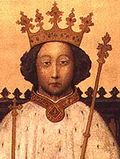 |
Richard IIb. 6 Jan 1367, Bordeaux, Aquitaine |
| Title: | By the Grace of God, King of England and France and Lord of Ireland (Dei Gracia Rex Anglie et Francie Dominus Hibernie) |
| Term: | 21 Jun 1377 - 30 Sep 1399 |
| Chronology: | 21 Jun 1377, succeeded his grandfather, Edward III (regnal years counted from 22 Jun 1377) |
| 16 Jul 1377, crowned, Westminster Abbey | |
| 29 Sep 1399, signed "Cession and Renunciation" | |
| 30 Sep 1399, "Cession and Renunciation" accepted by Parliament, which then deposed Richard and deprived him of his kingship | |
| Names/titles: | Prince of Wales, Duke of Cornwall, Earl of Chester [from 20 Nov 1376] |
| Biography: | |
Born in Aquitaine, Richard was the son of the Prince of Wales, known to his contemporaries as Edward of Woodstock and named the Black Prince by later chroniclers. He was brought to England in 1371 and created Prince of Wales (20 Nov 1376) upon his father's death (8 Jun 1376). Richard succeeded his grandfather, Edward III, at the age of ten, but no regency was appointed. Until 1380 the day-to-day business of the government was carried on by a succession of "continual councils". Despite his young age, Richard showed precocious courage and tact in dealing with the rebels under Wat Tyler during the Peasants' Revolt in 1381. A year later Richard conflicted with Parliament, which refused to grant new taxation and forced the king to dismiss his favorite, Sir Michael de la Pole. A group of noblemen known as the Lords Appellant — the duke of Gloucester and the earls of Warwick, Arundel, Nottingham, and Derby — brought an accusatio, or formal appeal, against his allies of treason. The king's army led by Robert de Vere was defeated at Radcot Bridge (20 Dec 1387) and the Appellants occupied London. In 1388 the "Merciless Parliament" sentenced to death two main allies of the king and forced Richard to renew his coronation oath. In early 1390's Richard reasserted the royal authority and appointed a number of hard-working ministers. He attempted to establish an authoritarian rule and succeeded in arresting or banishing many of his opponents including Henry of Bolingbroke (future Henry IV), his cousin. Trying to reestablish English authority in Ireland, Richard ventured two expeditions [1]. During his second absence, Bolingbroke invaded England (July 1399). The English nobility supported the invasion and the Duke of York, who was made keeper of the realm by Richard, submitted to Henry. Returning to England in August 1399, Richard surrendered to Bolingbroke without a fight. After a lengthy process of persuasion, Richard signed his "Cession and Renunciation" (29 Sep 1399) ("... I fully, willingly, directly and totally renounce my right to the rule, governance and administration of these kingdoms and dominions... together with the name, honour, regality and majesty of kingship"). On 30 Sep 1399 the Parliament [2] convened and accepted Richard's abdication by acclamation. Then it proceeded with appointing commissioners, who passed the sentence declaring Richard deprived and deposed of the kingship and the throne therefore vacant. This sentence was again approved by acclamation and Henry of Bolingbroke was approved as a new king. In October 1399 Richard was imprisoned in Pontefract Castle, where he died four months later, possibly by starving himself to death. Biography source: [3; 4; 5] |
|
| | |
| [1] | During the absences of Richard II, his uncle, Edmund duke of York, served as keeper of the realm (custos): Oct 1394 - May 1395 and May 1399 - July 1399. |
| [2] | In fact, the assembly convened on 30 Sep 1399 was not Parliament because the king was not on the throne and no Speaker was elected. |
| [3] | Handbook of British Chronology (1986) |
| [4] | "Richard II", by Nigel Saul (Yale Univ. Press, 1997). |
| [5] | "Chronicles of the Revolution 1397-1400: The Reign of Richard II", translated and edited by Chris Given-Wilson (Manchester Univ. Press 1993). |
| Image: Richard II. Reproduction of a painting in Westminster Abbey by unknown artist. | |
